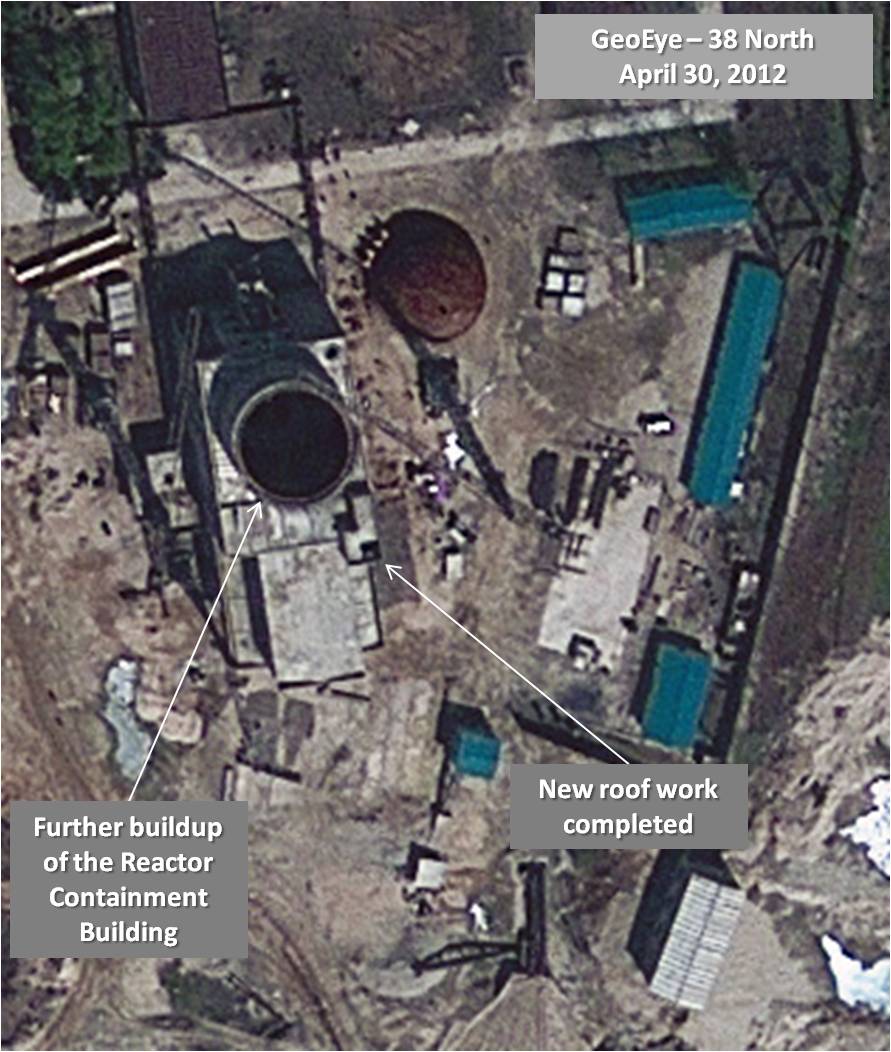North Korea Resumes Construction of Light Water Reactor: Completion of Buildings May Be Near
After months of inactivity, North Korea has resumed work on its new experimental light water reactor (ELWR), which the DPRK claims is intended to help solve domestic energy shortages, but is also an important component in its effort to build nuclear weapons. Commercial satellite photography from April 30, 2012 reveals that Pyongyang is now close to completion of the reactor containment building. The next major step in construction will be loading the heavy components, such as the pressure vessel, steam generator, and pressurizer, likely through the cylindrical opening in the roof of the reactor containment building. That process could take 6-12 months to complete. Overall, it may take another 1-2 years before the new facility becomes operational.
Previous analysis by 38 North documented the rapid progress made on the ELWR in 2011. However, work at the site halted by late December 2011 after completion of the roof for the turbine generator hall (see figure 1). A satellite photo from February 3, 2012 showed no change in the amount of construction at the site (see figure 2). Exactly why the work stopped remains unclear; it may have been due, in part, to the death of Kim Jong Il, but a more likely explanation was that winter weather was approaching.
Figure 1: The EWLR Construction Site at Yongbyon (December 24, 2011)

Figure 2. The ELWR Construction Site at Yongbyon (February 3. 2012)

Construction resumed, probably in late February or early March as demonstrated in a March 25, 2012 satellite photo showing new activity at the site and the beginning of work on the cylindrical portion of the reactor containment building (see figure 3).
Figure 3: Construction Resumes at the ELWR Construction Site at Yongbyon (March 25, 2012)

Based on the April 30 photo, it appears that the North may now be nearing completion of the reactor containment building (see figure 4). Steel rebar and concrete have been added to the cylindrical portion of the building that now appears higher than in previous photos. Additional work has been done on portions of the building’s roof adjacent to that area. There is also stepped-up activity on the ground likely related to renewed construction. The domed roof can still be seen in the same location as in previous satellite photos—in the area where the cylindrical sections have been assembled—ready for installation.
Figure 4: Further Buildup of the Reactor Containment Building (April 30, 2012)

The next major step in the construction of this facility will be the loading of the heavy components, such as the pressure vessel, steam generator, and pressurizer, likely through the cylindrical opening in the roof of the reactor containment building. Exactly when that process will begin is unclear; it depends on the availability of the heavy components. Recently, the North Koreans stated that those components were being manufactured parallel to the construction of the reactor buildings. The loading process could last 6-12 months.
North Korea’s plan for installing the reactor’s turbine generator remains unclear. The hall that will house the generators was completed in December 2011, but there is no evidence that the equipment was installed inside the building before the roof was finished. While the North Koreans may intend to move the generator into the building through a large door, it is difficult to spot such an opening through satellite photos.
Still further work—such as installing electronics in the control room and producing fuel assemblies—will need to be completed before the reactor is operational. That may take another 1-2 years after loading the heavy components. In short, the facility may not begin operating until 2014-2015.
Figure 5: 3D Model of the ELWR at Yongbyon
To navigate the model using a scroll wheel mouse: 1. Once loaded, click anywhere in the window 2. Slide scroll wheel to zoom in or out 3. Click and hold scroll wheel button to orbit 4. Click and hold left mouse to pan sideways 5. Click on icons for dimension information. Modeling done by Tamara Patton, Graduate Research Assistant at the James Martin Center for Nonproliferation Studies.
Pyongyang’s construction of an ELWR—which the North Koreans have indicated is the prototype for additional reactors—as well as a uranium enrichment facility at Yongbyon is an important indication of the North’s intention to move forward with the expansion of its nuclear weapons stockpile in the future. The uranium enrichment program is intended to produce fuel for the reactor and fissile material for its nuclear weapons. Moreover, as Olli Heinonen, the former Deputy Director General of the International Atomic Energy Agency recently argued, the ELWR, once operational, could also produce new plutonium—12 kilograms or a little more than one bomb per year—for Pyongyang’s nuclear weapons stockpile. The combination of these two efforts could allow the North to continue expansion of its stockpile well into the future.
Find more satellite imagery of the ELWR at Yongbyon.
